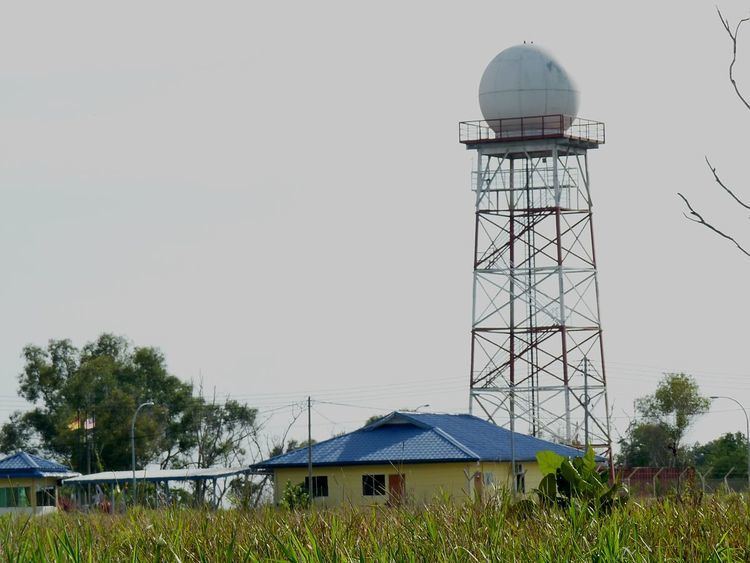The Malaysian Meteorological Department (formerly abbreviated as MMD and now MetMalaysia) is an agency of the Ministry of Science, Technology and Innovation (MOSTI). It is charged with gathering and providing results for the public in Malaysia, that are obtained from data based on daily scientific observation and research into natural phenomena in the fields of meteorology, hydrology, seismology and volcanology, among other related scientific fields. Its headquarters is located in Petaling Jaya, Selangor, Malaysia nearest to Taman Jaya LRT station.
1820- Meteorological observations started in Singapore.1883- Observations of air pressure, temperature and rainfall by the Department of Health began in Penang and Malacca.1906 - 1926- Meteorological Stations were established in the Federal Malay States hospitals to take routine observations.1921- Weather observations were carried out at Gunung Tahan (Pahang) for two years for studying the possibility of building a sanatorium.1924- The Museum Department took over the observation function.1927- Meteorological Branch in Peninsular Malaya was transferred to and created as a unit in the Survey Department.1930- The development of the Meteorological Branch of the Survey Department into a fully organized modern meteorological service unit.1931- The Pan Malayan Meteorological Headquarters was established in Singapore.1938- The post of Director, Malayan Meteorological Service was created.1 September 1946- Malayan Meteorological Service was established with its head office in Singapore.1958- Department of Meteorological Office was established in Simpang (Kuala Lumpur) Airport.1958- Malaysia deposited its instrument of accession to the WMO convention on 19 May 1958 and acceded to the convention.9 August 1963- Head office moved to Kuala Lumpur.9 August 1965- Malaysian Meteorological Service was established and placed under the Ministry of Transport with the separation of meteorological services in Malaysia and Singapore.1967- Research and Training Division was set up.1 April 1968- Malaysian Meteorological Service's headquarters building at Petaling Jaya was completed.1968- Satellite Meteorology Division and Electronic Data Processing Division were established.1 July 1969- Took over the Sabah and Sarawak Meteorological Service from the Department of Civil Aviation.1970- Hydrometeorology Unit was established.1973- Agrometeorology Division was established.1975- Establishment of Meteorological Instrument Unit, Environmental Studies Division, Marine Meteorology Division and Seismology Division.1984- Malaysian Meteorological Service was transferred to the Ministry of Science, Technology and the Environment (MOSTE) currently known as Ministry of Science, Technology and Innovation (MOSTI).1985- Butterworth Regional Meteorological Office was handed over to Malaysia Meteorological Services Department.15 August 1997- Central Forecast Office was established in Petaling Jaya Headquarter Office.1 July 1998- KLIA Regional Meteorological Office was officially operated in International Airport of KLIA, Sepang.18 December 2003- Malaysian Meteorological Services Department has won Anugerah Kualiti Perdana Menteri (Sektor Awam).November 2004- Gong Kedak Meteorological Office was established.28 September 2006- Malaysian Meteorological Services Department was changed to Malaysian Meteorological Department.23 March 2009- New logo of Malaysian Meteorological Department was launched.Maintain a technically advanced observation station network to support monitoring of weather conditions and seismic activities in the country.Issue timely meteorological information and forecasts for civil and military aviation, marine activities and general public.Provide early warnings on the occurrences of adverse weather phenomena and dangerous sea conditions in the Malaysian region to the public and relevant agencies involved in disaster mitigation.Provide immediate information on earthquake events that affect the country to the public, media and relevant government agencies involved in disaster mitigation.Provide seismological information to civil engineering and construction industries.Compile quality climatological, atmospheric composition and seismological data and prepare climatological statistics.Provide climatological services to users in all sectors of the economy upon request.Monitor atmospheric composition in Malaysia and provide information and technical advice on the meteorological aspects of air pollution.Conduct cloud seeding operations to increase water resources for agriculture and other purposes.Participation in international programmes on research, data collection and exchange, and other related activities in meteorology.Publish meteorological reports and bulletins.Provide training in meteorology.Promote public awareness on the importance and usefulness of meteorological and seismological information.Promote advancement of meteorological and seismological sciences through research.To be among the best of meteorological, climatological and geophysical service centre by 2020.
To fulfill the needs of the people of Malaysia for meteorological, climatological and geophysical services for national security, societal well-being and sustainable socio-economic development.
Enhance the meteorological, climatological and geophysical service system for:safety and operational efficiency in the air, land, sea and military;Homeland security (such as disaster management and threats from climate change, extreme weather, earthquake and tsunami);public safety and comfortsocial economic development planning and environmental managementEnhance the observation system, and establish and regulate the national database of meteorology, climate, seismology and tsunami to meet the needs of present and future generations.Protecting national interests at the international level and to promote the understanding and advancement meteorological, climatological, seismological and tsunami sciences in the country. 
